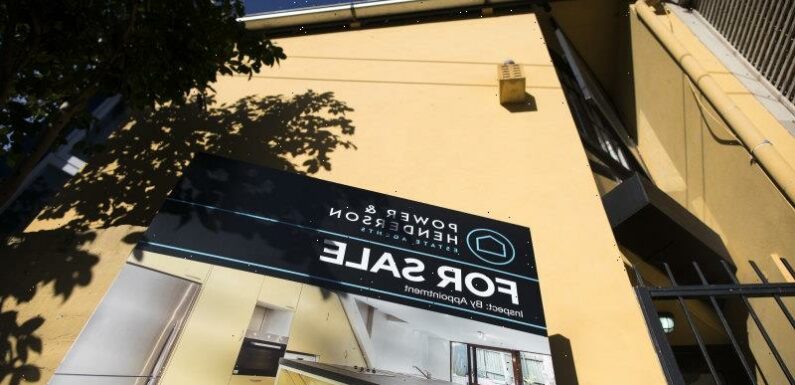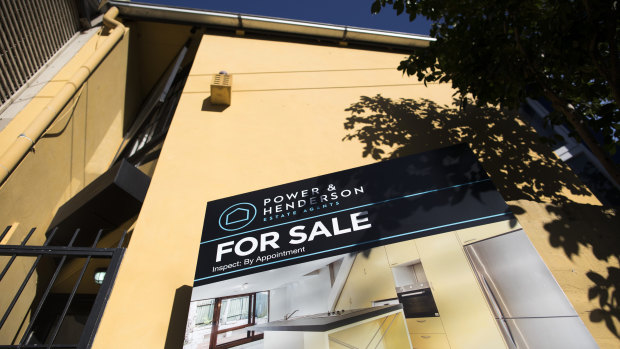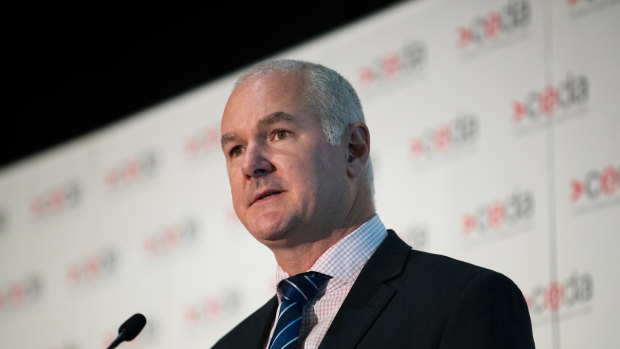
The Reserve Bank has fresh evidence the property market is rapidly slowing due to higher interest rates as new data shows the biggest fall in Sydney and Melbourne house prices since the depths of the global financial crisis.
But before the RBA board’s Tuesday meeting, at which markets expect the bank to lift official interest rates by another half percentage point, separate figures show the resources sector is expected to pump a record $450 billion back into the economy as demand and prices remain high for key mineral exports.
House values continue to fall as the Reserve Bank’s aggressive lift in official rates bites.Credit:Bloomberg
CoreLogic’s measure of dwelling values for September, released on Monday, showed a further 1.4 per cent drop across capital city markets. At an annual rate, dwelling values across all capital cities turned negative, slipping 0.7 per cent.
Sydney is the epicentre of the price correction. The median house value fell another 2.1 per cent to be down 7 per cent over the past three months. Through the year to date, the median house value in Sydney is down 9.2 per cent or by more than $100,000.
One of the hardest-hit parts of the country has been Sydney’s northern beaches, where values are down 14.5 per cent.
Melbourne’s median house value edged down another 1.2 per cent to be down 4.2 per cent over the quarter and by 6.2 per cent this year. Since peaking in February, Melbourne’s median house value has fallen by $63,000 to $937,000.
The markets in Brisbane and Canberra – the only city outside Sydney with a median value above $1 million – are also slowing quickly. Brisbane’s median house value fell 2 per cent in the quarter, although it is still up by 3.7 per cent so far this year, while Canberra’s median value is 5.2 per cent down over the quarter.
CoreLogic research director Tim Lawless said there were some signs of a slowdown in the rate of fall in dwelling values.
But he cautioned it could re-accelerate if the Reserve Bank continued to lift rates aggressively.
“It’s possible we have seen the initial shock of a rapid rise in interest rates pass through the market and most borrowers and prospective home buyers have now ‘priced in’ further rate hikes,” he said.
“However, if interest rates continue to rise as rapidly as they have since May, we could see the rate of decline in housing values accelerate once again.”
CoreLogic’s Tim Lawless says falling house values will accelerate if the Reserve Bank continues with large interest rate increases.Credit:Janie Barrett
Despite the fall in values, all markets are still ahead of their pandemic-period lows. Sydney values rose 27 per cent through the pandemic, while Melbourne’s rose 17.3 per cent. The hottest market was Adelaide, where values rose 44.7 per cent through the pandemic and had since fallen 0.3 per cent.
Financial markets put the chance of a half percentage point increase in the official cash rate at the RBA’s Tuesday meeting at four-in-five. The same markets expect the cash rate, currently 2.35 per cent, to be above 4 per cent by the middle of next year.
But the turmoil in global financial markets, most recently highlighted by the surge in the price of British government debt after the Truss government’s poorly received mini-budget, has some economists believing the RBA may lift rates by a quarter percentage point and then wait to see how the economy responds.
Treasurer Jim Chalmers on Sunday said the economic situation globally was becoming tougher.
“The global environment is a dangerous and difficult place right now. Even in the last month or two, the global situation has deteriorated dramatically in many of the major economies that we monitor most closely, the chance of a recession has edged over from possible to probable,” he said.
But figures from the Industry, Science and Resources Department released on Monday suggest a key part of the Australian economy is likely to remain extremely strong through the current financial year and continue pumping money into the country.
The department expects resource and energy exports to reach a record $450 billion this year, a $28 billion rise on last financial year.
Exports of iron ore are expected to edge down from $134 billion to $119 billion this year. Thermal coal, which has surged in price, is expected to be worth $62 billion this year after $46 billion in 2021-22, but metallurgical coal exports are forecast to slip to $58 billion from $66 billion.
The department said LNG exports were tipped to hit $90 billion from $70 billion due to the rise in global prices.
Minerals tied to the growing renewable energy and battery markets are now rising strongly in value.
Exports of copper, nickel and lithium are expected to be worth $33 billion this year, double what they were worth in 2020-21.
“Lithium export earnings are forecast to increase by more than tenfold in just two years from $1.1 billion in 2020–21 to almost $14 billion in 2022-23 before easing to around $13 billion in 2023-24,” it said.
The Business Briefing newsletter delivers major stories, exclusive coverage and expert opinion. Sign up to get it every weekday morning.
Most Viewed in Politics
From our partners
Source: Read Full Article

